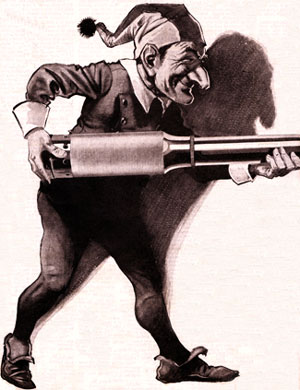A Goodell-Pratt Home Page
Brought to you by oldtoolheaven.com
 The Goodell-Pratt Company, a large manufacturer of carpenters' and machinists' tools, disappeared from the hardware scene when it was merged with the Millers Falls Company in 1931. Created from the Goodell Brothers Company by William M. Pratt, the firm was one of many tool companies to fall victim to the economic difficulties accompanying the Great Depression. Pratt represented the third generation of his family to be involved in the tool business, and although his abilities lay on the sales and finance side of the Goodell-Pratt operation, the quality of his factories' products was first-rate. The Goodell-Pratt Company grew by means of its acquisition of a number of smaller firms, and the individuals associated with those concerns were uniformly talented and product-oriented. As a result, the history of the company is complex, and the relationships between the major players are varied and interesting.
The Goodell-Pratt Company, a large manufacturer of carpenters' and machinists' tools, disappeared from the hardware scene when it was merged with the Millers Falls Company in 1931. Created from the Goodell Brothers Company by William M. Pratt, the firm was one of many tool companies to fall victim to the economic difficulties accompanying the Great Depression. Pratt represented the third generation of his family to be involved in the tool business, and although his abilities lay on the sales and finance side of the Goodell-Pratt operation, the quality of his factories' products was first-rate. The Goodell-Pratt Company grew by means of its acquisition of a number of smaller firms, and the individuals associated with those concerns were uniformly talented and product-oriented. As a result, the history of the company is complex, and the relationships between the major players are varied and interesting.
One of the characters associated with the company, the whimsical figure seen at left, is at least as interesting—if not as instrumental—to the development of the business as those involved in its organization. Known as Mr. Punch, he began appearing in Goodell-Pratt advertisements for Popular Mechanics as early as 1915, and while his name served to remind customers of the many punches (hand, centering, tinners', etc.) sold by the company, customers would have immediately associated him the outrageous protagonist of the well-known Punch and Judy puppet entertainments. An odd figure, so ugly that he looks as if he couldn't sell a sandwich to a starving man, Mr. Punch enjoyed a successful fifteen-year run as the company's mascot. Most frequently seen in advertisements and catalogs from the late teens and early 1920s, Mr. Punch made one of his last outings for Goodell-Pratt with an appearance in the company's final catalog in 1930. Mr. Punch's primary task was to promote the company’s No. 185 automatic drill—one of the most well-designed tools in the line. Judging from the number of these drills that have survived, he excelled at his job.
 The Goodell-Pratt Company employed three other trademarks worthy of note. The earliest, in intermittent use from the turn of the century until 1930, consisted of a tripartite shield containing the abbreviation GP Co. Heavily used in promotional material, the mark was sometimes stamped on tools, as was the company's distinctive use of the word Toolsmiths. A deliberately archaic term, the word Toolsmiths was written in script and introduced circa 1903 to call attention to the craftsmanship inherent in the company’s tools. The Toolsmiths trademark remained in use until the publication of the operation's last catalog in 1930. The third mark, introduced about 1917, was the phrase 1500 Good Tools which served as a device for calling attention to the breadth of the product line. The 1500 Good Tools trademark survived the death of the company and was used by the Millers Falls Company to promote its connection to the Goodell-Pratt operation as late as 1957—a full twenty-six years after the companies merged and long after the G-P line had been reduced to a dozen or so products.
The Goodell-Pratt Company employed three other trademarks worthy of note. The earliest, in intermittent use from the turn of the century until 1930, consisted of a tripartite shield containing the abbreviation GP Co. Heavily used in promotional material, the mark was sometimes stamped on tools, as was the company's distinctive use of the word Toolsmiths. A deliberately archaic term, the word Toolsmiths was written in script and introduced circa 1903 to call attention to the craftsmanship inherent in the company’s tools. The Toolsmiths trademark remained in use until the publication of the operation's last catalog in 1930. The third mark, introduced about 1917, was the phrase 1500 Good Tools which served as a device for calling attention to the breadth of the product line. The 1500 Good Tools trademark survived the death of the company and was used by the Millers Falls Company to promote its connection to the Goodell-Pratt operation as late as 1957—a full twenty-six years after the companies merged and long after the G-P line had been reduced to a dozen or so products.
The illustration of Mr. Punch shown here is an edited version of the original appearing on page 154 of the November 15, 1920, issue of The Saturday Evening Post. Punch is seen cradling the back end of one of the company’s No. 185 automatic drills.